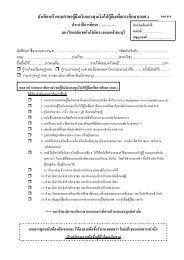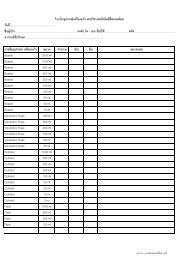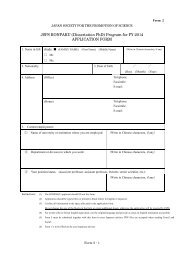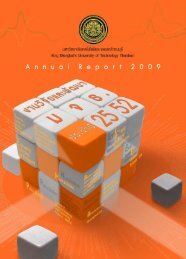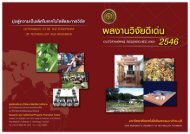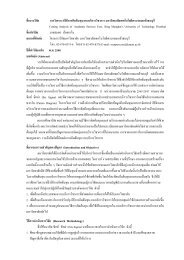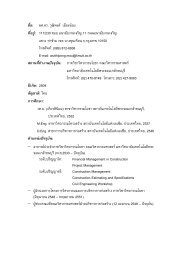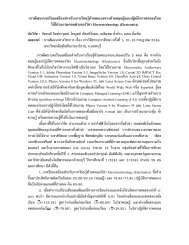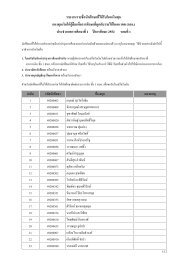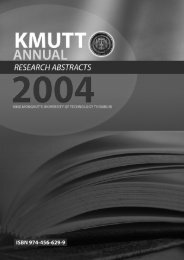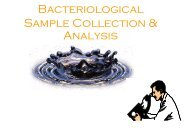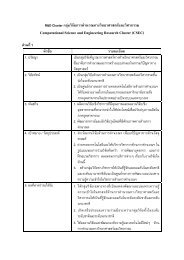You also want an ePaper? Increase the reach of your titles
YUMPU automatically turns print PDFs into web optimized ePapers that Google loves.
KMUTT Annual Research Abstracts 2005<br />
Paisarn Naphon, Somchai Wongwises<br />
Experimental Thermal and Fluid Science,<br />
Vol. 29, No. 4, 2005, pp. 511-521<br />
The heat transfer characteristics and the<br />
performance of a spiral coil heat exchanger<br />
under cooling and dehumidifying conditions are<br />
investigated. The heat exchanger consists of a<br />
steel shell and a spirally coiled tube unit. The<br />
spiral-coil unit consists of six layers of<br />
concentric spirally coiled tubes. Each tube is<br />
fabricated by bending a 9.27 mm diameter<br />
straight copper tube into a spiral-coil of five<br />
turns. Air and water are used as working fluids.<br />
The chilled water entering the outermost turn<br />
flows along the spirally coiled tube, and flows<br />
out at the innermost turn. The hot air enters the<br />
heat exchanger at the center of the shell and<br />
flows radially across spiral tubes to the<br />
periphery. A mathematical model based on mass<br />
and energy conservation is developed and solved<br />
by using the Newton–Raphson iterative method<br />
to determine the heat transfer characteristics.<br />
The results obtained from the model are in<br />
reasonable agreement with the present<br />
experimental data. The effects of various inlet<br />
conditions of working fluids flowing through the<br />
spiral coil heat exchanger are discussed.<br />
IJ-038 HEAT TRANSFER COEFFICIENTS<br />
UNDER DRY- AND WET-SURFACE<br />
CONDITIONS FOR A SPIRALLY COILED<br />
FINNED TUBE HEAT EXCHANGER<br />
Paisarn Naphon, Somchai Wongwises<br />
International Communications in Heat and Mass<br />
Transfer, Vol. 32, No. 3-4, February 2005,<br />
pp. 371-385<br />
In the present study, the average tubeside<br />
and air-side heat transfer coefficients in a<br />
spirally coiled finned tube heat exchanger<br />
under dry- and wet-surface conditions are<br />
experimentally investigated. The test section is a<br />
spiral-coil heat exchanger, which consists of six<br />
layers of concentric spirally coiled tube. Each<br />
tube is fabricated by bending a 9.6-mm outside<br />
diameter straight copper tube into a spiral coil of<br />
four turns. Aluminium fins with thickness 0.6<br />
mm and outside diameter 28.4 mm are placed<br />
helically around the tube. The chilled water and<br />
the hot air are used as working fluids. The test<br />
runs are done at the air and water mass flow<br />
rates ranging between 0.02 and 0.2 kg/s and<br />
between 0.04 and 0.25 kg/s, respectively. The<br />
15<br />
inlet-air and -water temperatures are between 35<br />
and 60 °C and between 10 and 35 °C,<br />
respectively. The effects of the inlet conditions<br />
of both working fluids flowing through the heat<br />
exchanger on the heat transfer coefficients are<br />
discussed. New correlations based on the data<br />
gathered during this work for predicting the<br />
tube-side and air-side heat transfer coefficients<br />
for the spirally coiled finned tube heat exchanger<br />
are proposed.<br />
IJ-039 TWO-PHASE FLOW OF<br />
REFRIGERANTS DURING EVAPORATION<br />
UNDER CONSTANT HEAT FLUX IN<br />
A HORIZONTAL TUBE<br />
Wisis Sripattrapan, Somchai Wongwises<br />
International Communications in Heat and Mass<br />
Transfer, Vol. 32, No. 3-4, February 2005,<br />
pp. 386-402<br />
This paper presents the results of<br />
simulations using a two-phase separated flow<br />
model to study the heat transfer and flow<br />
characteristics of refrigerants during evaporation<br />
in a horizontal tube. A one-dimensional annular<br />
flow model of the evaporation of refrigerants<br />
under constant heat flux is developed. The basic<br />
physical equations governing flow are<br />
established from the conservation of mass,<br />
energy and momentum. The model is validated<br />
by comparing it with the experimental data<br />
reported in literature. The present model can be<br />
used to predict the variation of the temperature,<br />
heat transfer coefficient and pressure drop of<br />
various pure refrigerants flowing along a<br />
horizontal tube. It is found that the refrigerant<br />
temperature decreases along the tube<br />
corresponding to the decreasing of its saturation<br />
pressure. The liquid heat transfer coefficient<br />
increases with the axial length due to the<br />
reducing thickness of the liquid film. The<br />
evaporation rate of liquid refrigerant tends to<br />
decrease with increasing axial length, due to the<br />
decreasing latent heat transfer through the<br />
liquid–vapor interface. The developed model<br />
can be considered as an effective tool for<br />
evaporator design and can be used to<br />
choose appropriate refrigerants under designed<br />
conditions.<br />
IJ-040 A TUBE-BY-TUBE REDUCTION<br />
METHOD FOR SIMULTANEOUS HEAT AND<br />
MASS TRANSFER CHARACTERISTICS FOR<br />
PLAIN FIN-AND-TUBE HEAT EXCHANGERS<br />
IN DEHUMIDIFYING CONDITIONS<br />
International Journal



